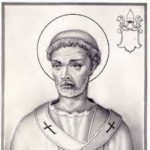
Pope Dionysius was the 25th pope of the catholic church. He served as Pope and the Bishop of Rome from 259 to 268 AD. He is a notable figure in early Christian history, especially during the turbulent times of the Roman Empire.
His papacy fell during a period of relative peace following the severe persecutions under Emperor Valerian, allowing him the opportunity to reorganize and strengthen the Church’s structure and address theological controversies.
Dionysius was instrumental in combating the Sabellian heresy, emphasizing the distinction between the Father, Son, and Holy Spirit, thus fostering the development of Trinitarian theology.
This guide aims to explore his life, his contributions to the Christian faith, and his enduring legacy in the history of the Church, offering insights into the challenges and achievements of his papacy.
Early Life
Historians know very little about the early life of Dionysius except that he was Greek and Italian. Though his family came from Greece, he was born in Italy sometime around 200 AD.
Some believe that he was born in the small town of Terra Nova, but others think that he was born in Magna Graecia. During his early years, he used the name Dionusius, which he changed to Dionysius upon becoming pope.
Papal Selection
Dionysius was not the first man chosen for the next pope after the death of Sixtus II. Pope Sixtus II was martyred as were many other Christians at the time.
Though the Church looked for a new pope, there were rumors that several men turned down the Holy See position because of the persecution they saw. It took nearly a year before Dionysius became the pope and the Bishop of Rome.
Little Peace of the Church
Pope Dionysius had an easier time than Sixtus II did mainly because of the murder of Emperor Valerian. Valerian was known for the persecution he did of Christians, but the King of Persia issued orders in 260 that led to the capture and murder of the former emperor.
Gallienus then became emperor and issued orders that called for the tolerance of Christians. The new emperor helped rebuild churches and allowed Christians to practice again. This period became known as the Little Peace of the Church, which lasted for nearly four decades.
Cappadocia
One thing associated with this pope was his support of followers in Cappadocia. This region is now in parts of modern-day Turkey and faced many attacks from invading Goths.
They not only destroyed some of the churches in the area but also kidnapped local people. The pope sent Church funds to those locals and asked them to use the money to both pay the ransoms for some of their people and to rebuild their churches.
Death and Burial
Though his predecessor ruled for less than one year, Pope Dionysius reigned for more than nine years and a total of 3,445 days. He was likely in his late 50s when he assumed the throne and in his late 60s when he passed away. Due to his age, many historians believe that he died of old ages or natural causes.
The pope passed away on December 26 in 268, and the Church later issued his sainthood feast day on the same date. As with previous popes, the Church had his body interned in the Cemetery of Callistus. Many recognize him today as a calm and peaceful man who worked hard for the Church and its followers in his role as the Holy See.
Quick Facts About Pope Dionysius
- Dionysius was Greek by birth and known as Dionusius.
- He was born circa 200 AD.
- The pope died on December 26, 268.
- He died of unknown causes but was likely in Rome at the time.
- His papacy began on July 22, 259.
- The papacy of Pope Dionysius ended on December 26, 268.
- His successor was Pope Saint Felix I who was chosen the month after Dionysius died.
Interesting Facts About Pope Dionysius
- Historical records sometimes confuse Pope Dionysius with Saint Dionysius the Great. Saint Dionysius the Great was the Bishop of Alexandria and ruled around the same time as the pope. He worked more closely with Emperor Gallienus than the pope did.
- In most of the images that depict Pope Dionysius, he’s shown wearing official vestments of the Catholic Church and holding a book in his hand. He also carries a crozier or crosier, which is a staff that depicts his position within the Church.
- One of the only letters Dionysius wrote during his papacy that still exists is one where he spoke out against the Sabellians. A second letter that he wrote to the people of Rome talks about the synod.
- According to early Church records, Dionysius was the first pope not martyred for his beliefs. The records seem to show that all of the popes who came before him were martyrs, including Peter who was the first pope of the Church.
- Dionysius achieved sainthood within the Roman Catholic Church. His feast day is held every year on December 26, the anniversary of his death.